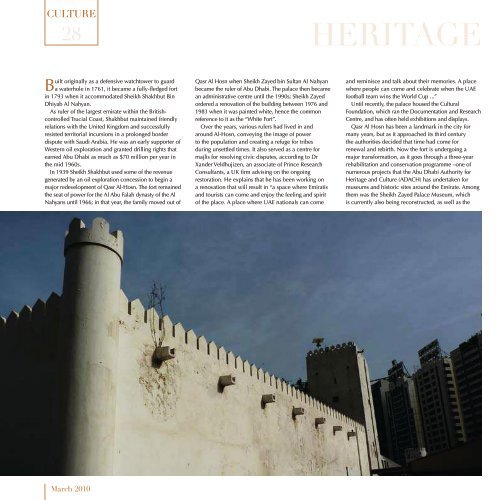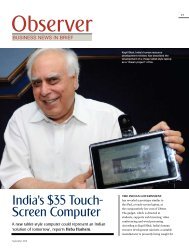Abu DhAbi ClAssiCs sCulpture symposium heritAge ... - Heba Hashem
Abu DhAbi ClAssiCs sCulpture symposium heritAge ... - Heba Hashem
Abu DhAbi ClAssiCs sCulpture symposium heritAge ... - Heba Hashem
- No tags were found...
Create successful ePaper yourself
Turn your PDF publications into a flip-book with our unique Google optimized e-Paper software.
heritage<br />
profile<br />
28 29<br />
Built originally as a defensive watchtower to guard<br />
a waterhole in 1761, it became a fully-fledged fort<br />
in 1793 when it accommodated Sheikh Shakhbut Bin<br />
Dhiyab Al Nahyan.<br />
As ruler of the largest emirate within the Britishcontrolled<br />
Trucial Coast, Shakhbut maintained friendly<br />
relations with the United Kingdom and successfully<br />
resisted territorial incursions in a prolonged border<br />
dispute with Saudi Arabia. He was an early supporter of<br />
Western oil exploration and granted drilling rights that<br />
earned <strong>Abu</strong> Dhabi as much as $70 million per year in<br />
the mid 1960s.<br />
In 1939 Sheikh Shakhbut used some of the revenue<br />
generated by an oil exploration concession to begin a<br />
major redevelopment of Qasr Al-Hosn. The fort remained<br />
the seat of power for the Al <strong>Abu</strong> Falah dynasty of the Al<br />
Nahyans until 1966; in that year, the family moved out of<br />
Qasr Al Hosn when Sheikh Zayed bin Sultan Al Nahyan<br />
became the ruler of <strong>Abu</strong> Dhabi. The palace then became<br />
an administrative centre until the 1990s; Sheikh Zayed<br />
ordered a renovation of the building between 1976 and<br />
1983 when it was painted white, hence the common<br />
reference to it as the “White Fort”.<br />
Over the years, various rulers had lived in and<br />
around Al-Hosn, conveying the image of power<br />
to the population and creating a refuge for tribes<br />
during unsettled times. It also served as a centre for<br />
majlis for resolving civic disputes, according to Dr<br />
Xander Veldhujizen, an associate of Prince Research<br />
Consultants, a UK firm advising on the ongoing<br />
restoration. He explains that he has been working on<br />
a renovation that will result in “a space where Emiratis<br />
and tourists can come and enjoy the feeling and spirit<br />
of the place. A place where UAE nationals can come<br />
and reminisce and talk about their memories. A place<br />
where people can come and celebrate when the UAE<br />
football team wins the World Cup ...”<br />
Until recently, the palace housed the Cultural<br />
Foundation, which ran the Documentation and Research<br />
Centre, and has often held exhibitions and displays.<br />
Qasr Al Hosn has been a landmark in the city for<br />
many years, but as it approached its third century<br />
the authorities decided that time had come for<br />
renewal and rebirth. Now the fort is undergoing a<br />
major transformation, as it goes through a three-year<br />
rehabilitation and conservation programme –one of<br />
numerous projects that the <strong>Abu</strong> Dhabi Authority for<br />
Heritage and Culture (ADACH) has undertaken for<br />
museums and historic sites around the Emirate. Among<br />
them was the Sheikh Zayed Palace Museum, which<br />
is currently also being reconstructed, as well as the<br />
Muwaiji Palace and Sheikh Zayed the First Museum,<br />
both being developed in Al Jahili Fort in Al Ain.<br />
Director-General of ADACH, Mohammed Khalaf Al<br />
Mazrouei, explains that “the authority is mandated to<br />
conserve, protect and promote the cultural heritage of<br />
the Emirate of <strong>Abu</strong> Dhabi; we have a commitment to<br />
vernacular heritage.<br />
“Al Jahili Fort in Al Ain, for example, has already<br />
undergone renovation. It has reopened to the public in<br />
2008, and draws large numbers of tourists, especially<br />
through the various cultural festivals organised here.<br />
Qasr Al Hosn ... is also undergoing a transformation<br />
towards making it a cultural attraction in the near future.”<br />
Meanwhile, Dr Sami El Masri, ADACH Deputy<br />
Director-General for Arts, Culture and Heritage and<br />
Director of Strategic Planning, notes that awareness<br />
campaigns are also run by the Authority to promote<br />
the Emirate locally, regionally and internationally. “We<br />
believe that this will trigger interest in the cultural<br />
field, thus resulting in more visits to the museums and<br />
changing the perception that heritage is unexciting.<br />
“Part of our goal is to offer a variety of cultural activities<br />
and experience, and highlight the many cultural sites that<br />
already exist in <strong>Abu</strong> Dhabi. This not only includes heritage<br />
sites, but also a dynamic experience that will encourage a<br />
longer stay in the emirate.”<br />
On the basis of these ambitious and promising<br />
initiatives, our anticipation of seeing Qasr Al Hosn<br />
develop into a lasting memorial site for <strong>Abu</strong> Dhabi<br />
and Al Nahyan Ruling Family persists, and the day that<br />
marks the end of this critical facelift will be celebrated<br />
with immense joy.<br />
March 2010 March 2010






